tuatara
Hero Member
- Jan 21, 2010
- 640
- 4
- Detector(s) used
- ML Explorer SE
There were times when Britain’s chief exports were criminals. Not that the country was so rich in that particular resource, just British standards for decent people were too high  . Anyway, almost all newly discovered lands became dumping areas for British outcasts. Soon, though, the colonies in their bid to become respectable were shutting down their penal settlements. However, at that critical moment for Britain, Western Australia decided to ship in some cheap labour for development of its infrastructure in remote rural locations. But the British establishment cheated and instead of an average Aussie sheep thief or a pocket picker, WA received several shipments of the most hardened crims. The common offences of those convicts were robbery with violence, stabbing, murder, arson and, of course, uttering counterfeit coins and bank notes.
. Anyway, almost all newly discovered lands became dumping areas for British outcasts. Soon, though, the colonies in their bid to become respectable were shutting down their penal settlements. However, at that critical moment for Britain, Western Australia decided to ship in some cheap labour for development of its infrastructure in remote rural locations. But the British establishment cheated and instead of an average Aussie sheep thief or a pocket picker, WA received several shipments of the most hardened crims. The common offences of those convicts were robbery with violence, stabbing, murder, arson and, of course, uttering counterfeit coins and bank notes.
All the week was stormy but I was looking forward to detecting in a little convict camp of the 1850’s–1870’s where once I found a prison button. There is no official record of the camp being there (probably there were too many of them then). Friday came, and the weather changed for the better. Early Saturday morning I grabbed my beeper and off I went for a long detecting trip. My very first signal sounded solid so I wasn’t surprised at all to see a coin inside the hole. However, when I took out what I assumed to be a ‘bun head’ farthing, something felt wrong. The ‘coin’ wasn’t weighty enough. I flipped it to the other side to see the date and … Any ideas what it is? An attempted counterfeit or just an ordinary farthing slashed somehow . Did they have lasers in the mid-19th century? Another solid signal and I saw a large copper. I touched it very suspiciously. But the only suspicious thing about this penny of 1851 was its excellent condition for an unearthed coin. In Victoria where we lived before, we recovered a number of old big coppers but all of them looked like cr%p because they were badly corroded. A bit aside I dug out 3 musket balls, a large strap buckle and a bunch of utility buttons. The next big signal brought me an EP fork bent into a loop closely followed by a Kings pattern EP spoonie. Several trashy signals turned out to be … trash. When at last I got a coin signal, a haypnee of 1851 appeared. Then something unexpected happened – I saw a tiny bronze or brass boot sticking out of sandy soil. I was disappointed that it was not St. Pete’s statuette (a copy of one found in Andorra
. Did they have lasers in the mid-19th century? Another solid signal and I saw a large copper. I touched it very suspiciously. But the only suspicious thing about this penny of 1851 was its excellent condition for an unearthed coin. In Victoria where we lived before, we recovered a number of old big coppers but all of them looked like cr%p because they were badly corroded. A bit aside I dug out 3 musket balls, a large strap buckle and a bunch of utility buttons. The next big signal brought me an EP fork bent into a loop closely followed by a Kings pattern EP spoonie. Several trashy signals turned out to be … trash. When at last I got a coin signal, a haypnee of 1851 appeared. Then something unexpected happened – I saw a tiny bronze or brass boot sticking out of sandy soil. I was disappointed that it was not St. Pete’s statuette (a copy of one found in Andorra  ). When I pulled it gently, I was left with what I thought a toy soldier’s leg in my hand. But the thing’s much more interesting than that – it is a military wax letter stamp.
). When I pulled it gently, I was left with what I thought a toy soldier’s leg in my hand. But the thing’s much more interesting than that – it is a military wax letter stamp.
 . Anyway, almost all newly discovered lands became dumping areas for British outcasts. Soon, though, the colonies in their bid to become respectable were shutting down their penal settlements. However, at that critical moment for Britain, Western Australia decided to ship in some cheap labour for development of its infrastructure in remote rural locations. But the British establishment cheated and instead of an average Aussie sheep thief or a pocket picker, WA received several shipments of the most hardened crims. The common offences of those convicts were robbery with violence, stabbing, murder, arson and, of course, uttering counterfeit coins and bank notes.
. Anyway, almost all newly discovered lands became dumping areas for British outcasts. Soon, though, the colonies in their bid to become respectable were shutting down their penal settlements. However, at that critical moment for Britain, Western Australia decided to ship in some cheap labour for development of its infrastructure in remote rural locations. But the British establishment cheated and instead of an average Aussie sheep thief or a pocket picker, WA received several shipments of the most hardened crims. The common offences of those convicts were robbery with violence, stabbing, murder, arson and, of course, uttering counterfeit coins and bank notes. All the week was stormy but I was looking forward to detecting in a little convict camp of the 1850’s–1870’s where once I found a prison button. There is no official record of the camp being there (probably there were too many of them then). Friday came, and the weather changed for the better. Early Saturday morning I grabbed my beeper and off I went for a long detecting trip. My very first signal sounded solid so I wasn’t surprised at all to see a coin inside the hole. However, when I took out what I assumed to be a ‘bun head’ farthing, something felt wrong. The ‘coin’ wasn’t weighty enough. I flipped it to the other side to see the date and … Any ideas what it is? An attempted counterfeit or just an ordinary farthing slashed somehow
 . Did they have lasers in the mid-19th century? Another solid signal and I saw a large copper. I touched it very suspiciously. But the only suspicious thing about this penny of 1851 was its excellent condition for an unearthed coin. In Victoria where we lived before, we recovered a number of old big coppers but all of them looked like cr%p because they were badly corroded. A bit aside I dug out 3 musket balls, a large strap buckle and a bunch of utility buttons. The next big signal brought me an EP fork bent into a loop closely followed by a Kings pattern EP spoonie. Several trashy signals turned out to be … trash. When at last I got a coin signal, a haypnee of 1851 appeared. Then something unexpected happened – I saw a tiny bronze or brass boot sticking out of sandy soil. I was disappointed that it was not St. Pete’s statuette (a copy of one found in Andorra
. Did they have lasers in the mid-19th century? Another solid signal and I saw a large copper. I touched it very suspiciously. But the only suspicious thing about this penny of 1851 was its excellent condition for an unearthed coin. In Victoria where we lived before, we recovered a number of old big coppers but all of them looked like cr%p because they were badly corroded. A bit aside I dug out 3 musket balls, a large strap buckle and a bunch of utility buttons. The next big signal brought me an EP fork bent into a loop closely followed by a Kings pattern EP spoonie. Several trashy signals turned out to be … trash. When at last I got a coin signal, a haypnee of 1851 appeared. Then something unexpected happened – I saw a tiny bronze or brass boot sticking out of sandy soil. I was disappointed that it was not St. Pete’s statuette (a copy of one found in Andorra  ). When I pulled it gently, I was left with what I thought a toy soldier’s leg in my hand. But the thing’s much more interesting than that – it is a military wax letter stamp.
). When I pulled it gently, I was left with what I thought a toy soldier’s leg in my hand. But the thing’s much more interesting than that – it is a military wax letter stamp.Attachments
Upvote
0


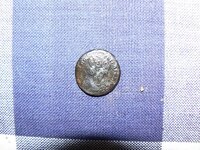
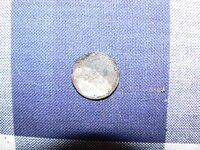
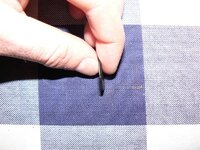
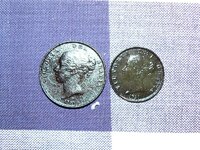
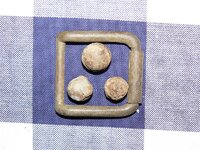
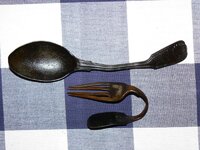
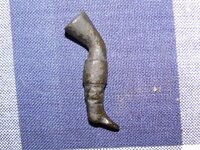
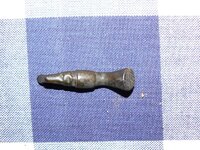

 Good finds altogether
Good finds altogether  Dd60
Dd60

